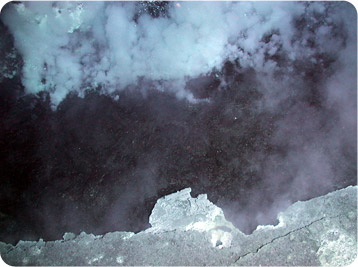121009daikoku.jpg

Daikoku Volcano. Credit: NOAA
The bottom of the sea is often described as “otherworldly.” It’s so different from what we see on land -- and so difficult to reach -- that it might as well be the surface of another planet.
But a pool of lava on the side of an undersea volcano takes the “otherworldly” business to a new level. It’s more like the volcanoes on one of the moons of Jupiter than those on Earth.
The volcano is known as Daikoku. It’s part of a chain of volcanoes in the western Pacific, south of Japan. The volcanoes form where one plate of Earth’s crust slides below another, melting some of the rock.
A couple of years ago, scientists discovered an odd crater about a quarter mile below the summit of Daikoku. It was covered with a black crust. When the researchers used a robotic submarine to poke through the crust, they found molten sulfur.
That may have been fairly common when Earth was young and its volcanoes were hotter. Today, though, it’s rare.
But sulfur volcanoes may be common on Io, a moon of Jupiter, where hundreds of volcanoes dot the landscape. They appear to create pools of molten sulfur with temperatures of a couple of thousand degrees Fahrenheit.
The scientists who discovered the Daikoku sulfur pool suspect that molten sulfur fills a large chamber inside the volcano. In part, that’s because a white cloud is bubbling out of the crater at its summit. But it’s too dangerous to check it out, even with robots. So the Daikoku volcano will hold on to its “otherworldly” mysteries for a while longer.

